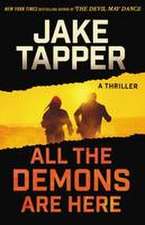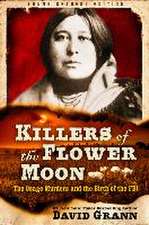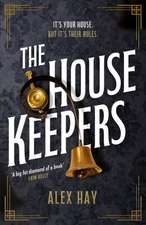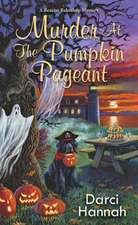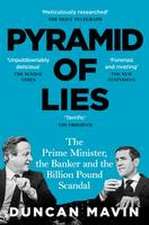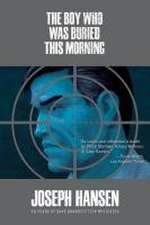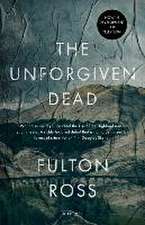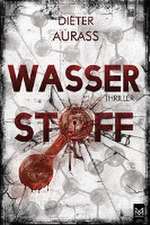The Devil and Sherlock Holmes: Tales of Murder, Madness and Obsession
Autor David Grannen Limba Engleză Paperback – 13 iun 2024
As Sherlock Holmes once conceded to Dr. Watson, 'If we could fly out of that window hand in hand, hover over this great city, gently remove the roofs and peep in at the queer things which are going on, the strange coincidences, the planning, the cross-purposes, the wonderful chain of events, working through generations and leading to the most outréresults, it would make all fiction with its conventionalities and foreseen conclusions most stale and unprofitable.' And with such a spirit for investigation and discovery does David Grann set out in The Devil and Sherlock Holmes to unravel the truth of twelve great, real-life mysteries.
Although Holmes is the subject of just one of the mesmerizing true stories in this collection, all twelve contain elements of intrigue. Many of the protagonists are sleuths: a Polish detective trying to determine whether an author planted clues to a real murder in his post-modern novel; an arson investigator racing to prove whether a man about to be executed is innocent; a legendary French con man questioning whether he is the one who is suddenly being conned; and scientists stalking a sea monster.
Unlike the adventures of Sherlock Holmes, these tales are all true. The protagonists are mortal and pieces of the puzzle often elude them. Some of the characters are driven to deception and murder. Others go mad.
But ultimately the stories contained in The Devil and Sherlock Holmes shed light on the human condition, and why some people on this earth devote themselves to good and others to evil. As Holmes put it, 'Life is infinitely stranger than anything which the mind of man could invent'.
| Toate formatele și edițiile | Preț | Express |
|---|---|---|
| Paperback (2) | 56.30 lei 26-38 zile | +24.14 lei 5-11 zile |
| Simon&Schuster – 13 iun 2024 | 56.30 lei 26-38 zile | +24.14 lei 5-11 zile |
| Vintage Books USA – 31 dec 2010 | 99.38 lei 22-36 zile |
Preț: 56.30 lei
Preț vechi: 69.98 lei
-20% Nou
Puncte Express: 84
Preț estimativ în valută:
10.78€ • 11.71$ • 9.06£
10.78€ • 11.71$ • 9.06£
Carte disponibilă
Livrare economică 04-16 aprilie
Livrare express 14-20 martie pentru 34.13 lei
Preluare comenzi: 021 569.72.76
Specificații
ISBN-13: 9781398540644
ISBN-10: 1398540641
Pagini: 352
Ilustrații: none
Dimensiuni: 130 x 198 x 30 mm
Greutate: 0.25 kg
Ediția:Reissue
Editura: Simon&Schuster
Colecția Simon & Schuster UK
ISBN-10: 1398540641
Pagini: 352
Ilustrații: none
Dimensiuni: 130 x 198 x 30 mm
Greutate: 0.25 kg
Ediția:Reissue
Editura: Simon&Schuster
Colecția Simon & Schuster UK
Descriere
An investigative odyssey from Samuel Johnson-shortlisted author David Grann to unravel twelve great, real-life mysteries
Notă biografică
David Grann is a staff writer at The New Yorker and author of the #1 New York Times bestseller The Lost City of Z, which has been translated into more than twenty-five languages and received the Indies Choice award for the best nonfiction book of 2009. He is a recipient of the George Polk Award for magazine reporting, and has written for the New York Times Magazine, the Atlantic, the Washington Post, the Wall Street Journal, and the New Republic.
Extras
Mysterious Circumstances
Richard Lancelyn Green, the world’s foremost expert on Sherlock Holmes, believed that he had finally solved the case of the missing papers. Over the past two decades, he had been looking for a trove of letters, diary entries, and manuscripts written by Sir Arthur Conan Doyle, the creator of Holmes. The archive was estimated to be worth nearly four million dollars, and was said by some to carry a deadly curse, like the one in the most famous Holmes story, “The Hound of the Baskervilles.”
The papers had disappeared after Conan Doyle died, in 1930, and without them no one had been able to write a definitive biography—a task that Green was determined to complete. Many scholars feared that the archive had been discarded or destroyed; as the London Times noted, its whereabouts had become “a mystery as tantalizing as any to unfold at 221B Baker Street,” the fictional den of Holmes and his fellow-sleuth, Dr. Watson.
Not long after Green launched his investigation, he discovered that one of Conan Doyle’s five children, Adrian, had, with the other heirs’ agreement, stashed the papers in a locked room of a château that he owned in Switzerland. Green then learned that Adrian had spirited some of the papers out of the château without his siblings’ knowledge, hoping to sell them to collectors. In the midst of this scheme, he died of a heart attack—giving rise to the legend of the curse. After Adrian’s death, the papers apparently vanished. And whenever Green tried to probe further he found himself caught in an impenetrable web of heirs—including a self-styled Russian princess—who seemed to have deceived and double-crossed one another in their efforts to control the archive.
For years, Green continued to sort through evidence and interview relatives, until one day the muddled trail led to London—and the doorstep of Jean Conan Doyle, the youngest of the author’s children. Tall and elegant, with silver hair, she was an imposing woman in her late sixties. (“Something very strong and forceful seems to be at the back of that wee body,” her father had written of Jean when she was five. “Her will is tremendous.”) Whereas her brother Adrian had been kicked out of the British Navy for insubordination, and her elder brother Denis was a playboy who had sat out the Second World War in America, she had become an officer in the Royal Air Force, and was honored, in 1963, as a Dame Commander of the Order of the British Empire.
She invited Green into her flat, where a portrait of her father, with his walrus mustache, hung near the fireplace. Green had almost as great an interest in her father as she did, and she began sharing her memories, as well as family photographs. She asked him to return, and one day, Green later told friends, she showed him some boxes that had been stored in a London solicitor’s office. Peering inside them, he said, he had glimpsed part of the archive. Dame Jean informed him that, because of an ongoing family dispute, she couldn’t yet allow him to read the papers, but she said that she intended to bequeath nearly all of them to the British Library, so that scholars could finally examine them. After she died, in 1997, Green eagerly awaited their transfer—but nothing happened.
Then, in March, 2004, Green opened the London Sunday Times and was shocked to read that the lost archive had “turned up” at Christie’s auction house and was to be sold, in May, for millions of dollars by three of Conan Doyle’s distant relatives; instead of going to the British Library, the contents would be scattered among private collectors around the world, who might keep them inaccessible to scholars. Green was sure that a mistake had been made, and hurried to Christie’s to inspect the materials. Upon his return, he told friends that he was certain that many of the papers were the same as those he had uncovered. What’s more, he alleged, they had been stolen—and he had proof.
Over the next few days, he approached members of the Sherlock Holmes Society of London, one of hundreds of fan clubs devoted to the detective. (Green had once been chairman.) He alerted other so-called Sherlockians, including various American members of the Baker Street Irregulars, an invitation-only group that was founded in 1934 and named after the street urchins Holmes regularly employed to ferret out information. Green also contacted the more orthodox scholars of Conan Doyle, or Doyleans, about the sale. (Unlike Green, who moved between the two camps, many Doyleans distanced themselves from the Sherlockians, who often treated Holmes as if he were a real detective and refused to mention Conan Doyle by name.)
Green shared with these scholars what he knew about the archive’s provenance, revealing what he considered the most damning piece of evidence: a copy of Dame Jean’s will, which stated, “I give to The British Library all . . . my late father’s original papers, personal manuscripts, diaries, engagement books, and writings.” Determined to block the auction, the makeshift group of amateur sleuths presented its case to Members of Parliament. Toward the end of the month, as the group’s campaign intensified and its objections appeared in the press, Green hinted to his sister, Priscilla West, that someone was threatening him. Later, he sent her a cryptic note containing three phone numbers and the message “please keep these numbers safe.” He also called a reporter from the London Times, warning that “something” might happen to him.
On the night of Friday, March 26th, he had dinner with a longtime friend, Lawrence Keen, who later said that Green had confided in him that “an American was trying to bring him down.” After the two men left the restaurant, Green told Keen that they were being followed, and pointed to a car behind them.
The same evening, Priscilla West phoned her brother, and got his answering machine. She called repeatedly the next morning, but he still didn’t pick up. Alarmed, she went to his house and knocked on the door; there was no response. After several more attempts, she called the police, who came and broke open the entrance. Downstairs, the police found the body of Green lying on his bed, surrounded by Sherlock Holmes books and posters, with a cord wrapped around his neck. He had been garroted.
“I will lay out the whole case for you,” John Gibson, one of Green’s closest friends, told me when I phoned him shortly after learning of Green’s death. Gibson had written several books with Green, including “My Evening with Sherlock Holmes,” a 1981 collection of parodies and pastiches of the detective stories. With a slight stammer, Gibson said of his friend’s death, “It’s a complete and utter mystery.”
Not long after, I travelled to Great Bookham, a village thirty miles south of London, where Gibson lives. He was waiting for me when I stepped off the train. He was tall and rail-thin, and everything about him—narrow shoulders, long face, unruly gray hair—seemed to slouch forward, as if he were supported by an invisible cane. “I have a file for you,” he said, as we drove off in his car. “As you’ll see, there are plenty of clues and not a lot of answers.”
He sped through town, past a twelfth-century stone church and a row of cottages, until he stopped at a red brick house surrounded by hedges. “You don’t mind dogs, I hope,” he said. “I’ve two cocker spaniels. I only wanted one but the person I got them from said that they were inseparable, and so I took them both and they’ve been fighting ever since.”
When he opened the front door, both spaniels leaped on us, then at each other. They trailed us into the living room, which was filled with piles of antique books, some reaching to the ceiling. Among the stacks was a near-complete set of The Strand Magazine, in which the Holmes stories were serialized at the turn of the twentieth century; a single issue, which used to sell for half a shilling, is now worth as much as five hundred dollars. “Altogether, there must be about sixty thousand books,” Gibson said.
We sat on a couch and he opened his case file, carefully spreading the pages around him. “All right, dogs. Don’t disturb us,” he said. He looked up at me. “Now I’ll tell you the whole story.”
Gibson said that he had attended the coroner’s inquest and taken careful notes, and as he spoke he picked up a magnifying glass beside him and peered through it at several crumpled pieces of paper. “I write everything on scraps,” he said. The police, he said, had found only a few unusual things at the scene. There was the cord around Green’s neck—a black shoelace. There was a wooden spoon near his hand, and several stuffed animals on the bed. And there was a partially empty bottle of gin.
The police found no sign of forced entry and assumed that Green had committed suicide. Yet there was no note, and Sir Colin Berry, the president of the British Academy of Forensic Sciences, testified to the coroner that, in his thirty-year career, he had seen only one suicide by garroting. “One,” Gibson repeated. Self-garroting is extremely difficult to do, he explained; people who attempt it typically pass out before they are asphyxiated. Moreover, in this instance, the cord was not a thick rope but a shoelace, making the feat even more unlikely.
Gibson reached into his file and handed me a sheet of paper with numbers on it. “Take a look,” he said. “My phone records.” The records showed that he and Green had spoken repeatedly during the week before his death; if the police had bothered to obtain Green’s records, Gibson went on, they would no doubt show that Green had called him only hours before he died. “I was probably the last person to speak to him,” he said. The police, however, had never questioned him.
During one of their last conversations about the auction, Gibson recalled, Green had said he was afraid of something.
“You’ve got nothing to worry about,” Gibson told him.
“No, I’m worried,” Green said.
“What? You fear for your life?”
“I do.”
Gibson said that, at the time, he didn’t take the threat seriously but advised Green not to answer his door unless he was sure who it was.
Gibson glanced at his notes. There was something else, he said, something critical. On the eve of his death, he reminded me, Green had spoken to his friend Keen about an “American” who was trying to ruin him. The following day, Gibson said, he had called Green’s house and heard a strange greeting on the answering machine. “Instead of getting Richard’s voice in this sort of Oxford accent, which had been on the machine for a decade,” Gibson recalled, “I got an American voice that said, ‘Sorry, not available.’ I said, ‘What the hell is going on?’ I thought I must’ve dialled the wrong number. So I dialled really slowly again. I got the American voice. I said, ‘Christ almighty.’ ”
Gibson said that Green’s sister had heard the same recorded greeting, which was one reason that she had rushed to his house. Reaching into his file, Gibson handed me several more documents. “Make sure you keep them in chronological order,” he said. There was a copy of Jean Conan Doyle’s will, several newspaper clippings on the auction, an obituary, and a Christie’s catalogue.
That was pretty much all he had. The police, Gibson said, had not conducted any forensic tests or looked for fingerprints. And the coroner—who had once attended a meeting of the Sherlock Holmes Society to conduct a mock inquest of the murder from a Conan Doyle story in which a corpse is discovered in a locked room—found himself stymied. Gibson said that the coroner had noted that there was not enough evidence to ascertain what had happened, and, as a result, the official verdict regarding whether Green had killed himself or been murdered was left open.
Within hours of Green’s death, Sherlockians seized upon the mystery, as if it were another case in the canon. In a Web chat room, one person, who called himself “inspector,” wrote, “As for self-garroting, it is like trying to choke oneself to death by your own hands.” Others invoked the “curse,” as if only the supernatural could explain it. Gibson handed me an article from a British tabloid that was headlined “ ‘curse of conan doyle’ strikes holmes expert.”
“So what do you think?” Gibson asked.
“I’m not sure,” I said.
Later, we went through the evidence again. I asked Gibson if he knew whose phone numbers were on the note that Green had sent to his sister.
Gibson shook his head. “It hadn’t come up at the inquest,” he said.
“What about the American voice on the answering machine?” I asked. “Do we know who that is?”
“Unfortunately, not a clue. To me that’s the strangest and most telling piece of evidence. Did Richard put that on his machine? What was he trying to tell us? Did the murderer put it there? And, if so, why would he do that?”
I asked if Green had ever displayed any irrational behavior. “No, never,” he said. “He was the most levelheaded man I ever met.”
He noted that Priscilla West had testified at the inquest that her brother had no history of depression. Indeed, Green’s physician wrote to the court to say that he had not treated Green for any illnesses for a decade.
“One last question,” I said. “Was anything taken out of the apartment?”
“Not that we know of. Richard had a valuable collection of Sherlock Holmes and Conan Doyle books, and nothing appears to be missing.”
As Gibson drove me back to the train station, he said, “Please, you must stay on the case. The police seem to have let poor Richard down.” Then he advised, “As Sherlock Holmes says, ‘When you have eliminated the impossible, whatever remains, however improbable, must be the truth.’ ”
Some facts about Richard Green are easy to discern—those which illuminate the circumstances of his life, rather than the circumstances of his death. He was born on July 10, 1953; he was the youngest of three children; his father was Roger Lancelyn Green, a best-selling children’s author who popularized the Homeric myths and the legend of King Arthur, and who was a close friend of C. S. Lewis and J. R. R. Tolkien; and Richard was raised near Liverpool, on land that had been given to his ancestors in 1093, and where his family had resided ever since.
Nathaniel Hawthorne, who was the American consul in Liverpool in the eighteen-fifties, visited the house one summer, and he later described it in his “English Notebooks”:
We passed through a considerable extent of private road, and finally drove through a lawn, shaded with trees, and closely shaven, and reached the door of Poulton Hall. Part of the mansion is three or four hundred years old. . . . There is [a] curious, old, stately staircase, with a twisted balustrade, much like that of the old Province House in Boston. The drawing-room looks like a very handsome modern room, being beautifully painted, gilded, and paper-hung, with a white-marble fire- place, and rich furniture; so that the impression is that of newness, not of age.
By the time Richard was born, however, the Green family was, as one relative told me, “very English—a big house and no money.” The curtains were thin, the carpets were threadbare, and a cold draft often swirled through the corridors.
From the Hardcover edition.
Richard Lancelyn Green, the world’s foremost expert on Sherlock Holmes, believed that he had finally solved the case of the missing papers. Over the past two decades, he had been looking for a trove of letters, diary entries, and manuscripts written by Sir Arthur Conan Doyle, the creator of Holmes. The archive was estimated to be worth nearly four million dollars, and was said by some to carry a deadly curse, like the one in the most famous Holmes story, “The Hound of the Baskervilles.”
The papers had disappeared after Conan Doyle died, in 1930, and without them no one had been able to write a definitive biography—a task that Green was determined to complete. Many scholars feared that the archive had been discarded or destroyed; as the London Times noted, its whereabouts had become “a mystery as tantalizing as any to unfold at 221B Baker Street,” the fictional den of Holmes and his fellow-sleuth, Dr. Watson.
Not long after Green launched his investigation, he discovered that one of Conan Doyle’s five children, Adrian, had, with the other heirs’ agreement, stashed the papers in a locked room of a château that he owned in Switzerland. Green then learned that Adrian had spirited some of the papers out of the château without his siblings’ knowledge, hoping to sell them to collectors. In the midst of this scheme, he died of a heart attack—giving rise to the legend of the curse. After Adrian’s death, the papers apparently vanished. And whenever Green tried to probe further he found himself caught in an impenetrable web of heirs—including a self-styled Russian princess—who seemed to have deceived and double-crossed one another in their efforts to control the archive.
For years, Green continued to sort through evidence and interview relatives, until one day the muddled trail led to London—and the doorstep of Jean Conan Doyle, the youngest of the author’s children. Tall and elegant, with silver hair, she was an imposing woman in her late sixties. (“Something very strong and forceful seems to be at the back of that wee body,” her father had written of Jean when she was five. “Her will is tremendous.”) Whereas her brother Adrian had been kicked out of the British Navy for insubordination, and her elder brother Denis was a playboy who had sat out the Second World War in America, she had become an officer in the Royal Air Force, and was honored, in 1963, as a Dame Commander of the Order of the British Empire.
She invited Green into her flat, where a portrait of her father, with his walrus mustache, hung near the fireplace. Green had almost as great an interest in her father as she did, and she began sharing her memories, as well as family photographs. She asked him to return, and one day, Green later told friends, she showed him some boxes that had been stored in a London solicitor’s office. Peering inside them, he said, he had glimpsed part of the archive. Dame Jean informed him that, because of an ongoing family dispute, she couldn’t yet allow him to read the papers, but she said that she intended to bequeath nearly all of them to the British Library, so that scholars could finally examine them. After she died, in 1997, Green eagerly awaited their transfer—but nothing happened.
Then, in March, 2004, Green opened the London Sunday Times and was shocked to read that the lost archive had “turned up” at Christie’s auction house and was to be sold, in May, for millions of dollars by three of Conan Doyle’s distant relatives; instead of going to the British Library, the contents would be scattered among private collectors around the world, who might keep them inaccessible to scholars. Green was sure that a mistake had been made, and hurried to Christie’s to inspect the materials. Upon his return, he told friends that he was certain that many of the papers were the same as those he had uncovered. What’s more, he alleged, they had been stolen—and he had proof.
Over the next few days, he approached members of the Sherlock Holmes Society of London, one of hundreds of fan clubs devoted to the detective. (Green had once been chairman.) He alerted other so-called Sherlockians, including various American members of the Baker Street Irregulars, an invitation-only group that was founded in 1934 and named after the street urchins Holmes regularly employed to ferret out information. Green also contacted the more orthodox scholars of Conan Doyle, or Doyleans, about the sale. (Unlike Green, who moved between the two camps, many Doyleans distanced themselves from the Sherlockians, who often treated Holmes as if he were a real detective and refused to mention Conan Doyle by name.)
Green shared with these scholars what he knew about the archive’s provenance, revealing what he considered the most damning piece of evidence: a copy of Dame Jean’s will, which stated, “I give to The British Library all . . . my late father’s original papers, personal manuscripts, diaries, engagement books, and writings.” Determined to block the auction, the makeshift group of amateur sleuths presented its case to Members of Parliament. Toward the end of the month, as the group’s campaign intensified and its objections appeared in the press, Green hinted to his sister, Priscilla West, that someone was threatening him. Later, he sent her a cryptic note containing three phone numbers and the message “please keep these numbers safe.” He also called a reporter from the London Times, warning that “something” might happen to him.
On the night of Friday, March 26th, he had dinner with a longtime friend, Lawrence Keen, who later said that Green had confided in him that “an American was trying to bring him down.” After the two men left the restaurant, Green told Keen that they were being followed, and pointed to a car behind them.
The same evening, Priscilla West phoned her brother, and got his answering machine. She called repeatedly the next morning, but he still didn’t pick up. Alarmed, she went to his house and knocked on the door; there was no response. After several more attempts, she called the police, who came and broke open the entrance. Downstairs, the police found the body of Green lying on his bed, surrounded by Sherlock Holmes books and posters, with a cord wrapped around his neck. He had been garroted.
“I will lay out the whole case for you,” John Gibson, one of Green’s closest friends, told me when I phoned him shortly after learning of Green’s death. Gibson had written several books with Green, including “My Evening with Sherlock Holmes,” a 1981 collection of parodies and pastiches of the detective stories. With a slight stammer, Gibson said of his friend’s death, “It’s a complete and utter mystery.”
Not long after, I travelled to Great Bookham, a village thirty miles south of London, where Gibson lives. He was waiting for me when I stepped off the train. He was tall and rail-thin, and everything about him—narrow shoulders, long face, unruly gray hair—seemed to slouch forward, as if he were supported by an invisible cane. “I have a file for you,” he said, as we drove off in his car. “As you’ll see, there are plenty of clues and not a lot of answers.”
He sped through town, past a twelfth-century stone church and a row of cottages, until he stopped at a red brick house surrounded by hedges. “You don’t mind dogs, I hope,” he said. “I’ve two cocker spaniels. I only wanted one but the person I got them from said that they were inseparable, and so I took them both and they’ve been fighting ever since.”
When he opened the front door, both spaniels leaped on us, then at each other. They trailed us into the living room, which was filled with piles of antique books, some reaching to the ceiling. Among the stacks was a near-complete set of The Strand Magazine, in which the Holmes stories were serialized at the turn of the twentieth century; a single issue, which used to sell for half a shilling, is now worth as much as five hundred dollars. “Altogether, there must be about sixty thousand books,” Gibson said.
We sat on a couch and he opened his case file, carefully spreading the pages around him. “All right, dogs. Don’t disturb us,” he said. He looked up at me. “Now I’ll tell you the whole story.”
Gibson said that he had attended the coroner’s inquest and taken careful notes, and as he spoke he picked up a magnifying glass beside him and peered through it at several crumpled pieces of paper. “I write everything on scraps,” he said. The police, he said, had found only a few unusual things at the scene. There was the cord around Green’s neck—a black shoelace. There was a wooden spoon near his hand, and several stuffed animals on the bed. And there was a partially empty bottle of gin.
The police found no sign of forced entry and assumed that Green had committed suicide. Yet there was no note, and Sir Colin Berry, the president of the British Academy of Forensic Sciences, testified to the coroner that, in his thirty-year career, he had seen only one suicide by garroting. “One,” Gibson repeated. Self-garroting is extremely difficult to do, he explained; people who attempt it typically pass out before they are asphyxiated. Moreover, in this instance, the cord was not a thick rope but a shoelace, making the feat even more unlikely.
Gibson reached into his file and handed me a sheet of paper with numbers on it. “Take a look,” he said. “My phone records.” The records showed that he and Green had spoken repeatedly during the week before his death; if the police had bothered to obtain Green’s records, Gibson went on, they would no doubt show that Green had called him only hours before he died. “I was probably the last person to speak to him,” he said. The police, however, had never questioned him.
During one of their last conversations about the auction, Gibson recalled, Green had said he was afraid of something.
“You’ve got nothing to worry about,” Gibson told him.
“No, I’m worried,” Green said.
“What? You fear for your life?”
“I do.”
Gibson said that, at the time, he didn’t take the threat seriously but advised Green not to answer his door unless he was sure who it was.
Gibson glanced at his notes. There was something else, he said, something critical. On the eve of his death, he reminded me, Green had spoken to his friend Keen about an “American” who was trying to ruin him. The following day, Gibson said, he had called Green’s house and heard a strange greeting on the answering machine. “Instead of getting Richard’s voice in this sort of Oxford accent, which had been on the machine for a decade,” Gibson recalled, “I got an American voice that said, ‘Sorry, not available.’ I said, ‘What the hell is going on?’ I thought I must’ve dialled the wrong number. So I dialled really slowly again. I got the American voice. I said, ‘Christ almighty.’ ”
Gibson said that Green’s sister had heard the same recorded greeting, which was one reason that she had rushed to his house. Reaching into his file, Gibson handed me several more documents. “Make sure you keep them in chronological order,” he said. There was a copy of Jean Conan Doyle’s will, several newspaper clippings on the auction, an obituary, and a Christie’s catalogue.
That was pretty much all he had. The police, Gibson said, had not conducted any forensic tests or looked for fingerprints. And the coroner—who had once attended a meeting of the Sherlock Holmes Society to conduct a mock inquest of the murder from a Conan Doyle story in which a corpse is discovered in a locked room—found himself stymied. Gibson said that the coroner had noted that there was not enough evidence to ascertain what had happened, and, as a result, the official verdict regarding whether Green had killed himself or been murdered was left open.
Within hours of Green’s death, Sherlockians seized upon the mystery, as if it were another case in the canon. In a Web chat room, one person, who called himself “inspector,” wrote, “As for self-garroting, it is like trying to choke oneself to death by your own hands.” Others invoked the “curse,” as if only the supernatural could explain it. Gibson handed me an article from a British tabloid that was headlined “ ‘curse of conan doyle’ strikes holmes expert.”
“So what do you think?” Gibson asked.
“I’m not sure,” I said.
Later, we went through the evidence again. I asked Gibson if he knew whose phone numbers were on the note that Green had sent to his sister.
Gibson shook his head. “It hadn’t come up at the inquest,” he said.
“What about the American voice on the answering machine?” I asked. “Do we know who that is?”
“Unfortunately, not a clue. To me that’s the strangest and most telling piece of evidence. Did Richard put that on his machine? What was he trying to tell us? Did the murderer put it there? And, if so, why would he do that?”
I asked if Green had ever displayed any irrational behavior. “No, never,” he said. “He was the most levelheaded man I ever met.”
He noted that Priscilla West had testified at the inquest that her brother had no history of depression. Indeed, Green’s physician wrote to the court to say that he had not treated Green for any illnesses for a decade.
“One last question,” I said. “Was anything taken out of the apartment?”
“Not that we know of. Richard had a valuable collection of Sherlock Holmes and Conan Doyle books, and nothing appears to be missing.”
As Gibson drove me back to the train station, he said, “Please, you must stay on the case. The police seem to have let poor Richard down.” Then he advised, “As Sherlock Holmes says, ‘When you have eliminated the impossible, whatever remains, however improbable, must be the truth.’ ”
Some facts about Richard Green are easy to discern—those which illuminate the circumstances of his life, rather than the circumstances of his death. He was born on July 10, 1953; he was the youngest of three children; his father was Roger Lancelyn Green, a best-selling children’s author who popularized the Homeric myths and the legend of King Arthur, and who was a close friend of C. S. Lewis and J. R. R. Tolkien; and Richard was raised near Liverpool, on land that had been given to his ancestors in 1093, and where his family had resided ever since.
Nathaniel Hawthorne, who was the American consul in Liverpool in the eighteen-fifties, visited the house one summer, and he later described it in his “English Notebooks”:
We passed through a considerable extent of private road, and finally drove through a lawn, shaded with trees, and closely shaven, and reached the door of Poulton Hall. Part of the mansion is three or four hundred years old. . . . There is [a] curious, old, stately staircase, with a twisted balustrade, much like that of the old Province House in Boston. The drawing-room looks like a very handsome modern room, being beautifully painted, gilded, and paper-hung, with a white-marble fire- place, and rich furniture; so that the impression is that of newness, not of age.
By the time Richard was born, however, the Green family was, as one relative told me, “very English—a big house and no money.” The curtains were thin, the carpets were threadbare, and a cold draft often swirled through the corridors.
From the Hardcover edition.
Recenzii
“Horrifying, hilarious, and outlandish. . . . These straightforward tales grip you as unrelentingly as the suckered appendages of the giant squid Grann attempts to track down in ‘The Squid Hunter.’”
—Entertainment Weekly (Grade: A)
“A gripping read. . . . Obsessives get themselves into some interesting places. Grann is the perfect guide to take you there.”
—The Miami Herald
“A dozen intricately crafted accounts. . . . Like the best of stories, each carries the spice of intrigue and the momentum of a search. . . . [They] will make your heart race and, at times, ache. They’re stories to share with friends, even if Grann can’t be there himself.”
—Cleveland Plain Dealer
“Grann’s obsession with how narratives are told is complex and compelling. . . . But it’s the basic stories themselves—bizarre and fascinating, bolstered by exhaustive research—that make the book so gripping.”
—Time Out New York
“Titillating. . . . Evidence of Grann’s abundant talent as a writer.”
—Providence Journal
“The most powerful essay I read this year was David Grann’s ‘Trial by Fire.’”
—David Brooks, The New York Times
“The truth is always stranger than fiction, even when it comes to murder mysteries. That’s the take-home lesson of Grann’s latest collection, which brings together 12 stories of real-life mysteries, each one stranger and more gripping than the last.”
—The Daily Beast
“A gifted storyteller, Grann has a Sherlock Holmesian gift for unearthing facts that are hidden in plain sight, presenting a crystal-clear narrative and letting his compelling cast of characters speak for themselves. . . . Easily worth the price of admission, a visit to Grann’s rogue’s gallery is likely to leave you with a sense, at once awful and awesome, of the profound desire we all have for recognition.”
—The Oregonian
"Beautifully constructed, highly improbably real life reports."
—GQ (UK)
“Eclectic. . . . Haunting. . . . Skilfully crafted. . . . [Grann] does not just tell these bizarre tales, he meets, interviews, gets to know and seems to understand many of his strange subjects.”
—The Irish Times
“There is humanity in the writing, and it’s all the more impressive that Grann manages to evoke it without drawing any attention to himself; his tales are first-person ones, but they don’t foreground the writer in that manner so popular among magazine editors today. Indeed, his selflessness as a writer, along with his gentle rectitude, cause him to bear a resemblance to another hero who never hogs the spotlight: Holmes’s assistant, Watson. Rarely does modesty produce such stunning results.”
—Bookforum
“Thoroughly documented, well written and full of surprises.”
—Toronto Star
“Grann’s in-depth reporting and vivid writing make this worthwhile reading for lovers of good journalism.”
—Booklist
"Chilling. . . . Poignant. . . . Haunting and gripping. . . . Gets into worlds that are otherwise invisible to us."
—Daily Mail (London)
"Grann is a worthy heir to Truman Capote."
—Le Monde (Paris)
—Entertainment Weekly (Grade: A)
“A gripping read. . . . Obsessives get themselves into some interesting places. Grann is the perfect guide to take you there.”
—The Miami Herald
“A dozen intricately crafted accounts. . . . Like the best of stories, each carries the spice of intrigue and the momentum of a search. . . . [They] will make your heart race and, at times, ache. They’re stories to share with friends, even if Grann can’t be there himself.”
—Cleveland Plain Dealer
“Grann’s obsession with how narratives are told is complex and compelling. . . . But it’s the basic stories themselves—bizarre and fascinating, bolstered by exhaustive research—that make the book so gripping.”
—Time Out New York
“Titillating. . . . Evidence of Grann’s abundant talent as a writer.”
—Providence Journal
“The most powerful essay I read this year was David Grann’s ‘Trial by Fire.’”
—David Brooks, The New York Times
“The truth is always stranger than fiction, even when it comes to murder mysteries. That’s the take-home lesson of Grann’s latest collection, which brings together 12 stories of real-life mysteries, each one stranger and more gripping than the last.”
—The Daily Beast
“A gifted storyteller, Grann has a Sherlock Holmesian gift for unearthing facts that are hidden in plain sight, presenting a crystal-clear narrative and letting his compelling cast of characters speak for themselves. . . . Easily worth the price of admission, a visit to Grann’s rogue’s gallery is likely to leave you with a sense, at once awful and awesome, of the profound desire we all have for recognition.”
—The Oregonian
"Beautifully constructed, highly improbably real life reports."
—GQ (UK)
“Eclectic. . . . Haunting. . . . Skilfully crafted. . . . [Grann] does not just tell these bizarre tales, he meets, interviews, gets to know and seems to understand many of his strange subjects.”
—The Irish Times
“There is humanity in the writing, and it’s all the more impressive that Grann manages to evoke it without drawing any attention to himself; his tales are first-person ones, but they don’t foreground the writer in that manner so popular among magazine editors today. Indeed, his selflessness as a writer, along with his gentle rectitude, cause him to bear a resemblance to another hero who never hogs the spotlight: Holmes’s assistant, Watson. Rarely does modesty produce such stunning results.”
—Bookforum
“Thoroughly documented, well written and full of surprises.”
—Toronto Star
“Grann’s in-depth reporting and vivid writing make this worthwhile reading for lovers of good journalism.”
—Booklist
"Chilling. . . . Poignant. . . . Haunting and gripping. . . . Gets into worlds that are otherwise invisible to us."
—Daily Mail (London)
"Grann is a worthy heir to Truman Capote."
—Le Monde (Paris)

